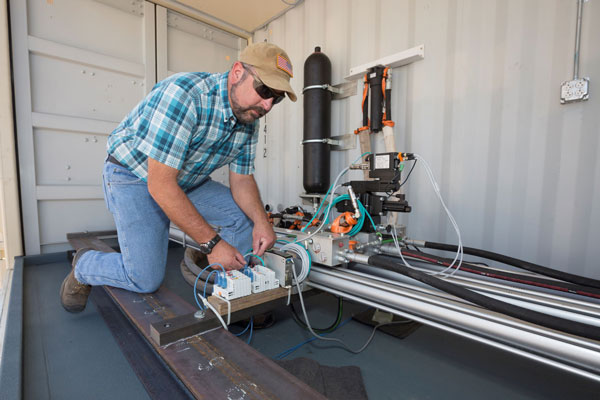
A new Sandia facility — the Sandia Wave Energy Power Take-Off (SWEPT) Lab — offers mobile, specialized testing for systems that produce power from wave energy.
The new facility “allows water power developers and researchers to test their devices and tune their controls software by leveraging the national labs,” said Peter Kobos, manager for water power technologies. “This will help industry and researchers set themselves up for successful field demonstrations.”
Marine and hydrokinetic technologies convert the energy of waves, tides and river and ocean currents into electricity. Potentially, they can provide millions with locally sourced, renewable and reliable energy.
The wave energy converters are unique because they convert the oscillatory mechanical energy from ocean waves to generate electricity. This makes them different from such technologies as wind turbines or hydroelectric power plants that harness a relatively steady input of mechanical energy. Because of the unique way they convert energy, the converter power take-off systems require specialized design and testing methods and facilities such as the SWEPT Lab.
The power take-off systems comprise the generator and gearing stages that transform the energy of the ocean’s waves to electrical energy. Power take-off systems define key system dynamics that determine the amount of power a wave energy converter can produce, which affects the levelized cost of energy.
“The SWEPT Lab is an exciting new capability that will allow WEC developers to test their systems before they commit to the tremendous expense of a test in the ocean or a wave tank. This should decrease the costs and speed up the development of this promising renewable energy technology,” said Amy Halloran, program manager for renewable energy technologies.
The levelized cost of energy measures how much money must be earned per unit of per kilowatt or megawatt of electricity for an energy project to break even. It is often used to compare different energy production methods.
Reducing the levelized cost to produce energy is the key to commercialization of wave energy converters.
Reducing costs, accelerating technology development and decreasing the time needed for testing and development of marine energy technologies will help unleash the nation’s potential for future growth in use of marine energy resources, according to the DOE water power technologies office.
Research and engineering efforts in Sandia’s water power technology program help the emerging marine hydrokinetic industry overcome technical barriers to commercialization, she said.
Located at Sandia’s National Solar Thermal Test Facility, the SWEPT Lab can be moved where it is needed or most convenient. Peter said mobility is a key feature for large systems that are assembled at a shipyard. Composed of five mobile units, the lab includes the test container, two generators, a power unit, control unit and tool unit.
Prior to commissioning, the lab completed a series of tests to characterize the system and verify that it can conduct hardware-in-the-loop testing and system identification testing. The initial tests showed excellent performance, Peter said.